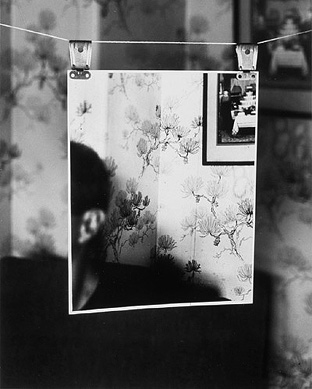By contradicting flatness and space, by underscoring the importance of perspective, I hope to confuse the objective with the subjective in a larger sense. As opposed to resolving issues, I want to increase a perception of tension, to dwell in that which is uncertain.
—Richard Koenig
Richard Koenig is an American photographer born in 1960. These set of images shown above are part of his “1999 Pearl Street” collection. Koenig works on layering images on top of one another to create an optical illusion, he tends to work in private spaces or intimate moments inset within a public space. It makes you think of memories that places and building may evoke on to you as memories are not always built around people but rather the places and object we frequently used.
Previous works include photographing “construction of the railroad as a landmark industrial achievement that shaped the course of American history.” Koneig is said to covey “the expansiveness of the tracks (the Central Pacific Railroad traverses 690 miles and the Union Pacific Railroad covers 1,086 miles) by using a panoramic lens to show an epic landscape, as if from the viewpoint of a passenger, while highlighting changes made to the land to accommodate its creation.”

“Richard Koenig completed his BFA from Pratt Institute, Brooklyn, New York (1985) and his MFA from Indiana University, Bloomington (1998). Solo exhibitions of his work have been held at Riley Gallery, Notre Dame University, South Bend, IN (2018); Kansas State University, Manhattan, KS (2013); and Richmond Center for Visual Arts, Western Michigan University, Kalamazoo, MI (2008); among many others. He is currently the Genevieve U. Gilmore Professor of Art at Kalamazoo College.”
Image Analysis:

This photograph follows the artist returning back to his childhood home and photographing rooms and parts of the house in which Koenig feels he has a strong connection to. I think these photos are very important as it not only helps the audience to think back to their childhood home and think of all their good and bad memories that has shaped the way we are today. I think that the emptiness of the image is also important as I am sure that when he was a child the house was filled with family and items like toys and furniture and now the emptiness helps to symbolise a piece that is missing, this could be due to the fact that a member of his household has dies or simply the fact that he has moved out and now only the memories is what remains. I think that having the image being in black and white is important as it brings up the contrast between the lights of the windows and the darks of the door frame, I helps us to focus on the patterns on the wall as they stand out as. The pattern on the wall also helps to give the image texture, which is also shown in the wooden panels on the floor. The eye is first lead to the door then around the clear image and then around to the out of focus part on the outside.
The fact that this is a image within an image allows the photograph to be more interesting as it looks 3D and makes the audience wonder why they chose to do it this way. My first thought is the similarity of the idea that he is hanging up the washing and putting the image in plain sight for the audience to see; however one might wonder if the artist is trying to hide something behind this image closest to us. It may also be down to personal preference and “contradicting flatness and space“. I think the artist works well with his aims of increasing “a perception of tension, to dwell in that which is uncertain.” as the images don’t have much context and can therefore help to leave a lot to the imagination. I think the use of two simple pins holding the image up can serve as a metaphor to show how fragile childhood memories are due to natural ageing as the older we get the more faded our childhood memories become as our brain uses the space for newer memories. The fact that the outside is out of focus also helps to symbolises this as it adds to the idea that we can’t remember all our memories or the whole memory as some parts may be forgotten about.
Sources:
Richard Koenig | Museum of Contemporary Photography (mocp.org)
Curriculum Vitae, Abridged (kzoo.edu)





